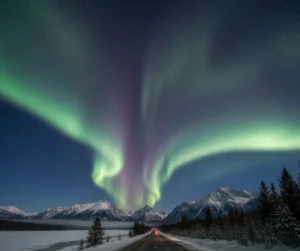The Northern Lights dazzled drivers across the United States, painting the night sky in vivid colors from Minnesota to Alabama — a rare celestial show that turned ordinary highways into glowing horizons.
On the night of November 11, the sky across much of the United States came alive with streaks of color more typical of the Arctic Circle than the American heartland. The aurora borealis—often reserved for Alaska or Canada—stretched deep into the southern states, astonishing onlookers from Kansas to Alabama. A powerful geomagnetic storm, caused by an intense burst of solar activity, was responsible for this remarkable spectacle.
According to the National Oceanic and Atmospheric Administration (NOAA), several strong coronal mass ejections (CMEs) from the Sun collided with Earth’s magnetic field over the weekend, producing one of the most vivid and far-reaching auroras in recent memory. The combination of strong solar winds and Earth’s atmospheric composition created conditions perfect for a dazzling light show that could be seen well beyond the usual latitudes.
Throughout the night, social media filled with photos and videos taken by long-haul truckers and night-shift transport workers who witnessed the sky erupt in electric hues while traveling along interstates and remote highways. Many described the experience as both mesmerizing and surreal—an unexpected glimpse of nature’s power in the middle of an ordinary work shift.
21 states in the United States are seeing the northern lights tonight.
— Chaya’s Clan (@ChayasClan) November 12, 2025
The video was filmed in Arkansas.
The images are from other states, including Iowa and Texas pic.twitter.com/siI1An6WUK
21 states in the United States are seeing the northern lights tonight.
— Chaya’s Clan (@ChayasClan) November 12, 2025
The video was filmed in Arkansas.
The images are from other states, including Iowa and Texas pic.twitter.com/siI1An6WUK
🌌 Northern Lights in real time — nature’s version of a divine light show.
— Dan Brisbois (@Dan_Brisbois) November 12, 2025
No filter, no CGI, just raw magnetic chaos painting the sky.
If you ever get to see it, remember… the universe doesn’t care who you are, but it’ll still put on a show for you.#NorthernLights… pic.twitter.com/d2CYNxxbde
The science behind the storm
Auroras occur when charged particles ejected from the Sun collide with gases in Earth’s atmosphere, such as oxygen and nitrogen. These collisions release energy in the form of light, creating glowing curtains that ripple across the sky. The color depends on the type of gas and altitude of the interaction: green and red tones arise from oxygen, while purples and blues are produced by nitrogen.
In this case, the event was triggered by three consecutive CMEs—massive bursts of plasma and magnetic field expelled from the Sun’s corona—that reached Earth in quick succession. The resulting geomagnetic disturbance was classified as a G4 storm, the second-highest level on NOAA’s five-step scale. Such powerful storms can push auroral activity far closer to the equator, allowing people in unexpected locations to witness the northern lights.
Residents of Minnesota, Wisconsin, and Michigan enjoyed particularly vivid displays under clear skies, while reports of visible auroras poured in from places rarely included in such lists—Oklahoma, Texas, and even northern Alabama.
A once-in-a-lifetime view for drivers
For truckers and other transport workers, the spectacle offered an unforgettable moment amid the long monotony of night routes. From the flat plains of the Midwest to the mountain passes of New Mexico, drivers pulled over to admire shimmering bands of light moving across the horizon.
Yet, alongside the beauty came practical concerns. Bright, shifting skies can distract drivers on long stretches of unlit road. Sudden changes in brightness or color may affect depth perception and spatial awareness, especially for those who have been driving for many hours. Additionally, geomagnetic storms can interfere with satellite signals, including GPS and radio communications, that are essential for modern logistics and fleet coordination.
Though no major incidents were reported, safety experts advised transport companies to treat such events as reminders of the importance of resilience and preparation. In rare but significant space-weather disturbances, even short disruptions can affect operations across large regions.
Strengthening safety under extraordinary skies
The November aurora emphasized that space weather—like snow, fog, or heavy rain—can have real implications for transportation safety. Industry specialists recommend several measures to mitigate risks during strong geomagnetic activity:
Integrate space-weather alerts into route-monitoring systems to warn drivers of potential signal disruptions or visibility changes.
Maintain backup navigation and communication tools, such as secondary GPS devices and alternative satellite networks, to ensure uninterrupted coordination.
Educate drivers about unusual atmospheric phenomena so they can stay focused and avoid distraction when encountering unexpected visual effects.
Proactive planning, experts note, is key to maintaining both safety and operational efficiency when nature behaves unpredictably.
Lit sky, safe road
The aurora borealis that illuminated the United States on November 11 did more than inspire awe—it connected the nation’s transport community to a rare cosmic event, blending the wonders of the universe with the everyday realities of the road.
For the thousands of truckers who caught a glimpse of the glowing horizon, the experience was a reminder of why many love the open highway: every night brings something new, and sometimes, even the sky itself puts on a show.
But for the transportation industry as a whole, it also underscored a vital lesson: whether under storms of snow or showers of light, safety and alertness remain the guiding stars that keep America moving.

Northern Lights Illuminate U.S. Highways and Surprise Nighttime Truckers
The Northern Lights dazzled drivers across the United States, painting the night sky in vivid colors from Minnesota to Alabama — a rare celestial show that turned ordinary highways into glowing horizons.

Operation Midway Blitz in Indiana leads to 146 truckers arrested
Operation Midway Blitz was carried out in coordination with the Indiana State Police, resulting in the arrest of 146 truck drivers. Raids conducted by the

Truckers for Troops: the trucking industry supports veterans
During Veterans Day, the trucking industry shows its support for active-duty service members and veterans. On November 11, we honor those who have served the

Cargo Theft: Why the Christmas Season Is the Most Critical Time of the Year
For the freight and logistics industry, Christmas brings enormous commercial opportunities—but also heightened exposure. Strengthening cargo security is not only a matter of technology or policing. It requires strategic planning, trained personnel, consistent internal protocols, and a culture of prevention.

Happy Birthday, Marines: 250 Years of Logistics Lessons for Trucking
The United States Marine Corps marks 250 years of history. Happy Birthday Marines.

Teton Pass bridge will be closed to traffic for 10 days
Teton Pass is one of the most heavily traveled routes for truck drivers in Wyoming, serving as a vital corridor for the trucking industry. The
